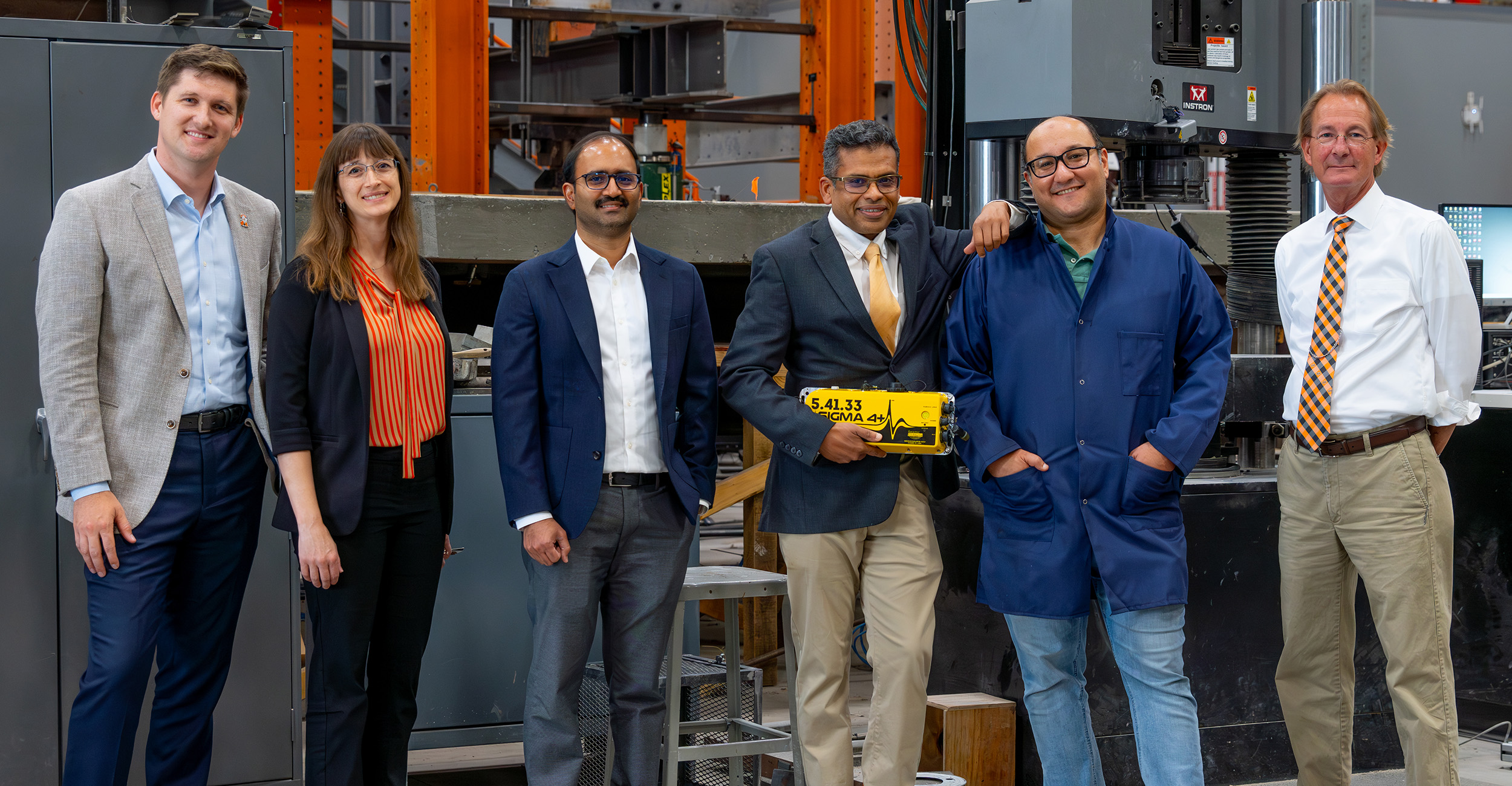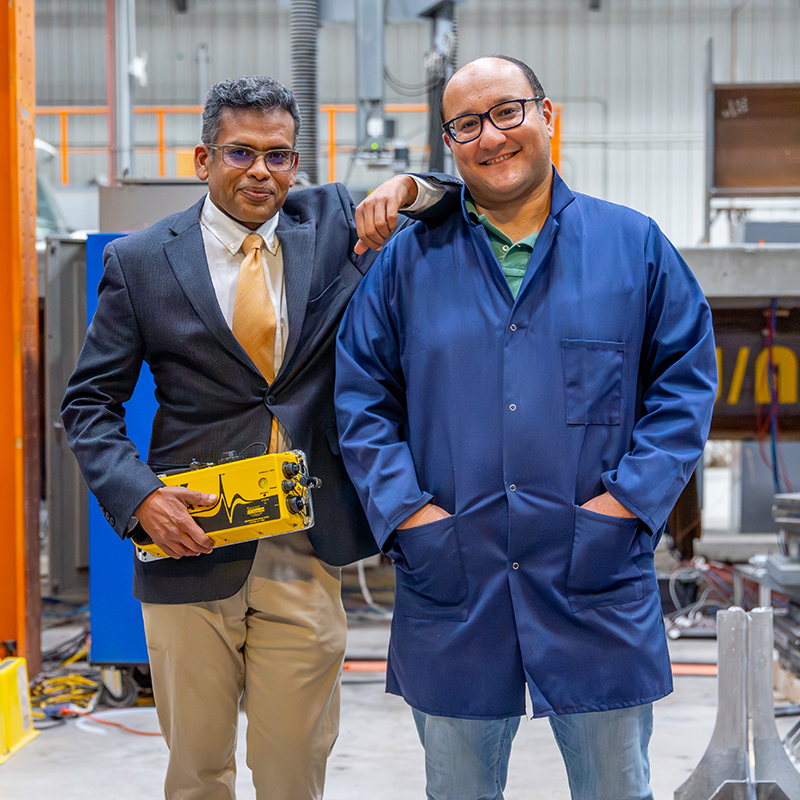
It Takes a Village
Monday, November 27, 2023
Media Contact: Terry Tush | Director of Marketing & Communications | 405-744-2703 | terry.tush@okstate.edu
Like many 10-year-olds, Arthur Jaiswal wondered what his father, Dr. Priyank Jaiswal, a geophysics professor at Oklahoma State University, did for a living. It’s no easy task to explain to a young boy what a geophysicist is, so Priyank took his son’s hand and placed it on the end of their kitchen table. Then, he walked to the other side and tapped the table firmly with an open hand.
“Did you feel the vibration?” Priyank asked his son, who nodded. “You can use basic math and physics to convert them into measuring the thickness and hardness of this countertop. Like I tapped the table, and you received the vibration, at work I do the same thing but with the Earth, which is essentially a stack of countertops made of different stones.”
That moment with his son may have been a simple illustration, but it summed up Jaiswal’s career since he earned his Ph.D. from Rice University in 2008 and moved to Stillwater a year later. He taps the ground at one location, records the vibration at another location and discovers a lot about the space in between. The process, which is as much an art as a science, can tell someone about the layers of rock under their feet. It can locate groundwater within the top 100 meters or oil and gas a mile below.
Jaiswal and his colleagues in OSU’s Boone Pickens School of Geology had been turning these vibrations into meaningful data for years when his “aha” moment happened over a barbecue lunch with his co-inventor, Dr. Mohamed Soliman, a structural engineering professor at OSU. They were discussing how the recent earthquakes had made the expansion of infrastructure in Oklahoma challenging.
“I almost went into a trance for a couple of seconds when I realized that we had the solution,” Jaiswal said.
Jaiswal proposed using his seismic tools to record the building’s vibration from passing traffic, high winds or even tiny earthquakes from the Earth’s persistent plate motion, and Soliman proposed using it to develop the building’s digital twin, which they could monitor over time for the building’s health. They wrote a grant proposal to the National Science Foundation around the idea.

They named the technology Intact, which Jaiswal describes as like a Fitbit for a building. They put Intact to the test at OSU’s Kerr Hall, a dormitory built in 1965 that was nearing the end of its lifespan by the early 2010s. The NSF gave Jaiswal and Soliman a grant in 2019 to rig up Kerr Hall with instruments to listen to the building during the seismic events that were rattling Stillwater during that time. They built the dorm’s digital twin with the resonance data, and the experiment was a success. They published their results in a peer-reviewed journal, thus getting their science verified and validated.
The Kerr Hall test showed that the science behind Intact was sound and that the applications of this invention were limitless. Intact could be used to measure the health of a dam, wind turbines, rail lines, homes or even ancient wonders. They even figured out how to monitor a building without constructing its digital twin, which saves priceless time and gives Intact a massive advantage over competitors.
“I think we have a viable system,” Soliman said. “Our goal is a plug-and-play solution with multiple sensors that can be easily attached to a structure. The sensors would send data to be analyzed, and we would use artificial intelligence to do the damage detection in real-time. You’ve heard of a smart home. We want a super smart home.”
Their invention may be viable, but neither Jaiswal nor Soliman knew the first thing about what to do next. After all, they were scientists. What did they know about turning their invention into a product people could purchase? Luckily, OSU put a system in place to help them do just that.
A group of OSU organizations joined forces to tap into the NSF’s Innovation Corps and its $7.5 billion commercialization budget. The Innovation Foundation at OSU, which includes the Office of Technology Commercialization, helps assess and protect the intellectual property of the researcher’s invention. Cowboy Technologies serves as the incubator that helps researchers explore the commercialization process in concert with the Spears School of Business.
Together, this group was awarded an NSF I-Corps Site program with a goal of taking OSU inventions and commercializing them.
“We want you to walk away with two things,” said John Nickel, the assistant director of Cowboy Technologies. “We want you to be able to say, ‘This is what my technology is excellent at, and these are the customers who care.’ If you have both of those things combined, you have product-market fit, and you might have a commercializable product on your hands.”
Richard Gajan is especially good at helping the inventors understand which customers would care about their product. An associate professor of professional practice with the Spears Business entrepreneurship department, Gajan earned mechanical engineering degrees from OSU and Texas A&M University, and he spent a decade working as an aircraft engineer and consultant. Itching for a change, Gajan decided to get his MBA from the University of Michigan in the late 1990s, and it changed his trajectory. He went on to work as a venture advisor at Tulsa’s i2E, a private firm that helps entrepreneurs launch their ideas. That led to his role as an OSU faculty member and the director and lead instructor of OSU’s I-Corps program.
Gajan has a knack for understanding both the technology and commercialization sides of the process. He, along with his former i2E coworker and Spears Business associate professor of professional practice David Thomison, take the inventors through the OSU I-Corps Site Program, which includes one-on-one coaching and 30 or more interviews with potential customers over a four-week process. The interviews are the key, because the inventor finds out what the public really thinks of their idea, who would buy it and why.
“You get to go out and talk to your customers to find out what their problems are,” Gajan said. “You find out how they do things, and then see how your research can make their lives better.”
Gajan and Thomison also put the researchers through a business model canvas, which helps them better understand their value proposition, customer segments, resources needed, revenue streams, infrastructure and even what advertising might be beneficial to their specific product. They also get a crash course on the soft skills of business that never come up in an engineering class, like how to introduce yourself to a potential client and how to explain your invention to people who aren’t specialists in your field.
For Jaiswal, these concepts were completely new and foreign, and he credits the OSU I-Corps Site Program for helping him see the world through a different lens. He points out that while researchers are taught to pursue problems, businesses pursue solutions. In research, a solution is only as good as the number of new questions it opens up. In business, it’s the opposite.
Researchers also tend to think in decades, but most businesses don’t even survive that long. The worlds of business and academia can be somewhat inverse and combining them can be an interesting challenge, he said.
“These programs have given me a split vision,” said Jaiswal, describing his efforts to coexist as a scientist and an entrepreneur. “For commercialization, I need to focus on what has been done, not what’s left to do. It’s a new mindset that I need to adopt. Thankfully though, I do not have to rediscover the wheel. OSU has an amazing support system.”
This new mindset has already paid off. Intact raced through the OSU I-Corps Site program and was accepted to the NSF’s $50,000 National I-Corps Program, which is the second of four steps in the I-Corps process. This seven-week program comes with more business training and increases the number of customer discovery interviews to 100 to validate the technology’s product-market fit.
“We want you to walk away with two things. We want you to be able to say, ‘This is what my technology is excellent at, and these are the customers who care.’ If you have both of those things combined, you have product-market fit, and you might have a commercializable product on your hands.”
John Nickel, assistant director of Cowboy Technologies
The third step in the I-Corps process is applying for the NSF’s Partnership for Innovation
grants, and Nickel thinks Priyank is the poster child for the PFI. In this phase,
teams are vying for $550,000 and $1 million grants that will help them move their
ideas from the lab to the marketplace. After receiving a PFI grant, teams will often
form startup companies and work their way toward the NSF’s final commercialization
step with a Small Business Innovation Research or Small Business Technology Transfer
grant submission.
Nationwide, 5,800 researchers have formed nearly 1,400 business startups because of the NSF’s I-Corps program, and those startups have combined to raise $3.16 billion in funding. The ripple effects of that investment will be seen across the planet for generations to come.
In Stillwater, the results have been just as impactful. OSU has sent 11 teams to I-Corps Nationals in the last three years — six in 2023 alone — which makes the university the 13th most prolific program in the country. In fact, OSU has the third most PFI awards in the nation with seven in the last three years. Over that three-year span, OSU has received a cumulative $2.65 million from these commercialization grants to further OSU Technologies.
As a Carnegie R1 Research University, OSU has a land-grant mission of providing knowledge and resources that improve lives. The university has 13 million square feet of facilities, 30 research centers and institutions, and has dedicated $184 million to game-changing research over the last decade. That investment has led to hundreds of invention disclosures that have kept the OSU I-Corps Site program busy.
Last September, the university was selected as one of five new I-Corps Hubs that will help scale the NSF-led National Innovation Network. OSU will receive $240,000 per year for five years as part of the regional alliance of nine universities in the Southwest, which includes the University of Texas at Austin, Louisiana State University, Mississippi State University, New Mexico State University, Rice University, Texas A&M University, the University of Texas at El Paso and the University of Texas at San Antonio.
That sum is a credit to the innovative approach OSU has for the commercialization of technologies and the team of faculty and staff members at the OSU I-Corps Hub program who have dedicated their careers to this effort. This campuswide initiative is the fruit of multiple departments looking beyond the agenda of their branch and understanding what is important for the tree.
“It’s the old adage, ‘it takes a village,’” Gajan said. “We have a little ecosystem.”
Story by: Stephen Howard I Discover@Spears Magazine
Photos by: Devin Flores
